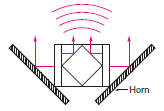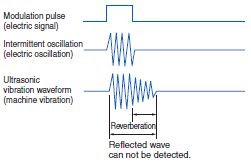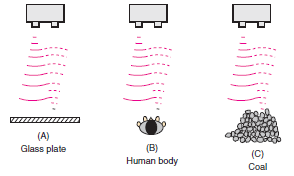Ultrasonic Sensors
|
|
Features |
| Principles | Classifications |
| Engineering Data |
|
| Explanation of Terms | Troubleshooting |
Speed of sound
The speed of sound "C" in air is C ≈ 331.5 + 0.61 θ (m/s), where θ is the air temperature (°C). The speed of sound changes as the air temperature changes, and this results in temperature-based distance measurement error.
Reflection and transmission
Ultrasound waves move straight forward in a uniform medium, and are reflected and transmitted at the boundary between differing media. This phenomenon is affected by the type and shape of the media. A human body in air causes considerable reflection and can be easily detected.
Multi-reflection
This occurs when ultrasound waves that have already reflected from the detection object once reflect from the sensor head surface, nearby walls, or the ceiling back to the detection object, and then back to the sensor.
For example, in the case of double reflection, the same ultrasound waves are received as a single reflection but at twice the distance.

Limit zone (reflective models)
Not only the maximum detection distance but also the minimum detection distance can be adjusted, in connection with or independently of the maximum distance. This detection range is called the limit zone (zone limit).

Non-sensitive zone and uncertainty zone (reflective models)
The non-sensitive zone is the interval between the surface of the sensor head and the minimum detection distance resulting from detection distance adjustment. The uncertainty zone is the area close to the sensor where detection is not possible due to the sensor head configuratin and reverberations.
Detection may occur in the uncertainty zone due to multireflection between the sensor and the object.
Directional characteristics
The ratio of the sound output (needed to transmit the specified sound energy to the target object) of the non-directivity emitter to the sound output of the directivity emitter is called the directivity gain.
As the frequency and vibration area increase, the directivity grows sharper and sound waves are emitted with greater efficiency.
The directivity of a sensor unit used as an ultrasound switch is 8° to 30° (sound pressure half-angle).
The directivity is also strongly affected by the shape of the sensor horn and the vibration mode of the transducer, and thus the sensor unit shape, operation frequency, and transducer type are selected to provide the desired operation range.

Sound pressure half angle
An index of directivity. The half angle is the angle from the center of the tranducer where the sound level (sound strength) is a maximum, to the point where the sound level is 1/2 the maximum (the sound decrease is symmetical, thus the angle is actually twice the above angle).
Side lobe
Directivity is indicated using a graph showing the sound level as a length from the center as the angle is shifted away from the angle of the transducer center, where the sound level (sound strength) is a maximum. As the angle increases from the center, the directivity decreases, and then after a certain point increases.
This is called the side lobe, and can result in stray reflection off peripheral objects that will affect the detection characteristics.
Transducer
This is a device which uses electrical energy to generate ultrasound waves, and which also converts ultrasound vibrational energy into electrical signals. A barium titanate transducer applying piezoelectric effect is normally used in ultrasound switches. The shape can be a disk or a tube.
Horn
This is a reflector that concentrates and emits ultrasound waves in a certain direction and also receives waves. The shape and dimensions of the horn determine the directivity characteristics of the sensor.

Transmitted waves
Ultrasound waves that are emitted in the specified direction when the transducer is connected to the oscillator. Normally expressed as a voltage applied to the transducer, or as a sound pressure.
Received waves
Transmitted ultrasound waves that are received at the transducer, and which are either direct or reflected from an object. Normally expressed as a converted voltage, or as a sound pressure.
Reverberation
When an electrical signal is applied to the transducer as a pulse at a frequency close to the resonance frequency of the transducer, the ultrasound vibration continues mechanically for a brief interval even after the electrical signal stops. This is called reverberation. If reverberation continues for a long time in a reflective sensor, detection becomes impossible.

Types and shapes of detection objects (reflective type)
Detected objects can be classified as follows:
(A) Flat-surface objects such as fluids, boxes, plastic sheets, paper, and glass.
(B) Cylindrical objects such as cans, bottles, and human bodies.
(C) Powders and chunk-like objects such as minerals, rocks, coal, coke, and plastic.
The reflective efficiency varies depending on the shape of these objects. In the case of (A), the greatest amount of reflected waves return, however, this is strongly affected by the inclination of the object. In the case of (B) and (C), stray reflectons occur and the reflected light is not uniform, however, the effect of inclination is small.



